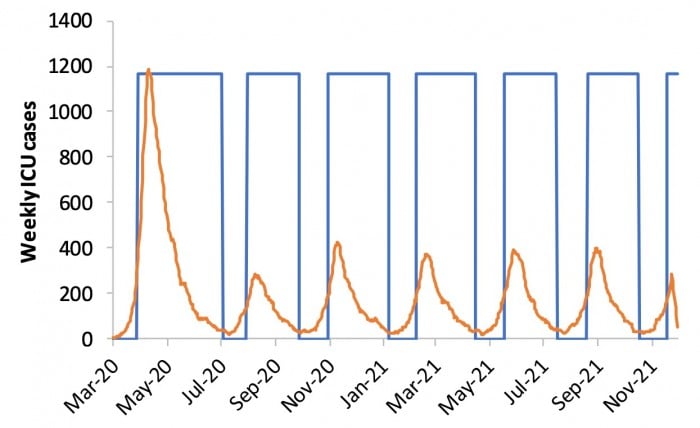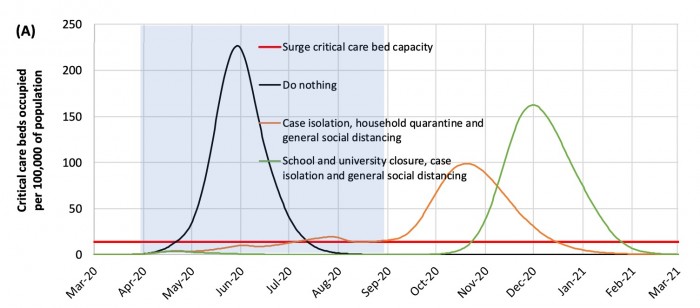You Can Only Change Family Plans Once Per Year Spotify
To stop coronavirus nosotros will need to radically modify almost everything nosotros do: how nosotros work, exercise, socialize, shop, manage our health, brainwash our kids, take care of family members.
We all desire things to get back to normal quickly. But what virtually of us have probably non yet realized—yet will presently—is that things won't go back to normal afterwards a few weeks, or fifty-fifty a few months. Some things never will.
Information technology'south now widely agreed (even past Britain, finally) that every state needs to "flatten the curve": impose social distancing to slow the spread of the virus so that the number of people sick at one time doesn't cause the health-care organization to collapse, as it is threatening to do in Italia correct now. That ways the pandemic needs to last, at a low level, until either enough people have had Covid-19 to exit most immune (assuming amnesty lasts for years, which we don't know) or there's a vaccine.
How long would that have, and how draconian do social restrictions need to exist? Yesterday President Donald Trump, announcing new guidelines such as a ten-person limit on gatherings, said that "with several weeks of focused action, we tin turn the corner and plow it quickly." In China, six weeks of lockdown are showtime to ease at present that new cases have fallen to a trickle.
But information technology won't stop there. As long as someone in the world has the virus, breakouts can and will keep recurring without stringent controls to contain them. In a written report yesterday (pdf), researchers at Imperial Higher London proposed a way of doing this: impose more extreme social distancing measures every fourth dimension admissions to intensive intendance units (ICUs) start to fasten, and relax them each fourth dimension admissions fall. Here's how that looks in a graph.

Imperial College Covid-19 Response Team.
The orange line is ICU admissions. Each fourth dimension they ascent above a threshold—say, 100 per week—the country would close all schools and nearly universities and prefer social distancing. When they drop below l, those measures would be lifted, merely people with symptoms or whose family members accept symptoms would nevertheless be confined at abode.
What counts as "social distancing"? The researchers define it as "All households reduce contact outside household, school or workplace by 75%." That doesn't mean you get to go out with your friends once a week instead of four times. It ways anybody does everything they tin can to minimize social contact, and overall, the number of contacts falls past 75%.
Nether this model, the researchers conclude, social distancing and schoolhouse closures would need to be in force some ii-thirds of the time—roughly two months on and one month off—until a vaccine is bachelor, which will take at to the lowest degree eighteen months (if it works at all). They annotation that the results are "qualitatively similar for the Usa."
Eighteen months!? Surely there must be other solutions. Why not simply build more ICUs and treat more people at one time, for case?
Well, in the researchers' model, that didn't solve the trouble. Without social distancing of the whole population, they constitute, even the best mitigation strategy—which means isolation or quarantine of the ill, the old, and those who take been exposed, plus school closures—would still lead to a surge of critically ill people viii times bigger than the United states or UK system can cope with. (That's the everyman, blue bend in the graph below; the flat reddish line is the electric current number of ICU beds.) Fifty-fifty if you set factories to churn out beds and ventilators and all the other facilities and supplies, you'd still need far more nurses and doctors to have care of everyone.

Majestic College Covid-19 Response Team
How about imposing restrictions for just one batch of 5 months or and so? No good—once measures are lifted, the pandemic breaks out all over again, only this time information technology's in winter, the worst time for overstretched health-care systems.

Regal Higher Covid-19 Response Team.
And what if we decided to be brutal: set the threshold number of ICU admissions for triggering social distancing much higher, accepting that many more than patients would die? Turns out information technology makes little difference. Fifty-fifty in the to the lowest degree restrictive of the Purple College scenarios, we're shut in more than than half the time.
This isn't a temporary disruption. It's the start of a completely different way of life.
Living in a land of pandemic
In the curt term, this will be hugely damaging to businesses that rely on people coming together in large numbers: restaurants, cafes, bars, nightclubs, gyms, hotels, theaters, cinemas, art galleries, shopping malls, craft fairs, museums, musicians and other performers, sporting venues (and sports teams), briefing venues (and conference producers), cruise lines, airlines, public transportation, private schools, solar day-care centers. That's to say goose egg of the stresses on parents thrust into home-schooling their kids, people trying to intendance for elderly relatives without exposing them to the virus, people trapped in calumniating relationships, and anyone without a fiscal cushion to deal with swings in income.
There'll be some adaptation, of grade: gyms could start selling home equipment and online grooming sessions, for example. We'll see an explosion of new services in what's already been dubbed the "shut-in economy." One can too wax hopeful about the way some habits might alter—less carbon-called-for travel, more local supply bondage, more walking and biking.
But the disruption to many, many businesses and livelihoods will be impossible to manage. And the shut-in lifestyle just isn't sustainable for such long periods.
Then how can we live in this new world? Part of the answer—hopefully—will be better health-intendance systems, with pandemic response units that can move apace to identify and contain outbreaks earlier they kickoff to spread, and the ability to quickly ramp upwardly production of medical equipment, testing kits, and drugs. Those will be as well belatedly to stop Covid-nineteen, only they'll help with future pandemics.
In the near term, we'll probably find bad-mannered compromises that let united states to retain some semblance of a social life. Maybe film theaters will take out half their seats, meetings volition be held in larger rooms with spaced-out chairs, and gyms volition require yous to book workouts ahead of time so they don't go crowded.
Ultimately, even so, I predict that we'll restore the ability to socialize safely past developing more sophisticated ways to identify who is a disease risk and who isn't, and discriminating—legally—against those who are.
We tin see harbingers of this in the measures some countries are taking today. Israel is going to use the jail cell-phone location data with which its intelligence services track terrorists to trace people who've been in touch with known carriers of the virus. Singapore does exhaustive contact tracing and publishes detailed data on each known example, all but identifying people by proper name.
Nosotros don't know exactly what this new future looks like, of form. But one tin imagine a earth in which, to go on a flight, mayhap you'll have to be signed up to a service that tracks your movements via your phone. The airline wouldn't be able to see where you'd gone, but information technology would get an alert if you'd been close to known infected people or affliction hot spots. There'd exist like requirements at the entrance to big venues, authorities buildings, or public send hubs. There would be temperature scanners everywhere, and your workplace might demand y'all wear a monitor that tracks your temperature or other vital signs. Where nightclubs ask for proof of age, in future they might ask for proof of amnesty—an identity bill of fare or some kind of digital verification via your phone, showing you've already recovered from or been vaccinated confronting the latest virus strains.
We'll adapt to and accept such measures, much as we've adapted to increasingly stringent airport security screenings in the wake of terrorist attacks. The intrusive surveillance will be considered a small price to pay for the bones freedom to exist with other people.
As usual, nevertheless, the true toll will be borne by the poorest and weakest. People with less access to health care, or who alive in more than illness-prone areas, volition now besides exist more frequently shut out of places and opportunities open to everyone else. Gig workers—from drivers to plumbers to freelance yoga instructors—will run across their jobs become fifty-fifty more precarious. Immigrants, refugees, the undocumented, and ex-convicts volition confront yet another obstacle to gaining a foothold in club.
Moreover, unless in that location are strict rules on how someone'southward hazard for affliction is assessed, governments or companies could choose whatsoever criteria—you lot're high-risk if you earn less than $50,000 a year, are in a family unit of more than six people, and live in sure parts of the country, for example. That creates telescopic for algorithmic bias and hidden discrimination, as happened terminal year with an algorithm used by US health insurers that turned out to inadvertently favor white people.
The world has changed many times, and it is irresolute once more. All of us will have to adapt to a new way of living, working, and forging relationships. But equally with all modify, in that location will exist some who lose more than nigh, and they will be the ones who have lost far besides much already. The all-time we can hope for is that the depth of this crunch will finally forcefulness countries—the Us, in item—to fix the yawning social inequities that make big swaths of their populations so intensely vulnerable.
Source: https://www.technologyreview.com/2020/03/17/905264/coronavirus-pandemic-social-distancing-18-months/
0 Response to "You Can Only Change Family Plans Once Per Year Spotify"
إرسال تعليق